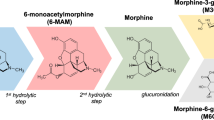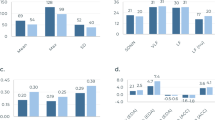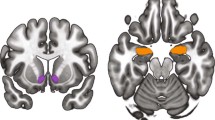Abstract
Reinforcing properties of psychoactive substances are considered to be critically involved in the development and maintenance of substance dependence. While accumulating evidence suggests that the sensitivity to reinforcement values may generally be altered in chronic substance users, relatively little is known about the influence reinforcing feedback exerts on ongoing decision-making in these individuals. Decision-making was investigated using the Cambridge Risk Task, in which there is a conflict between an unlikely large reward option and a likely small reward option. Responses on a given trial were analyzed with respect to the outcome on the previous trial, providing a measure of the impact of prior feedback in modulating behavior. Five different groups were compared: (i) chronic amphetamine users, (ii) chronic opiate users in methadone maintenance treatment (MMT), (iii) chronic users of illicit heroin, (iv) ex-drug users who had been long-term amphetamine / opiate users but were abstinent from all drugs of abuse for at least 1 year and (v) matched controls without a history of illicit substance use. Contrary to our predictions, choice preference was modified in response to feedback only in opiate users enrolled in MMT. Following a loss, the MMT opiate group chose the likely small reward option significantly less frequently than controls and heroin users. Our results suggest that different opiates are associated with distinctive behavioral responses to feedback. These findings are discussed with respect to the different mechanisms of action of heroin and methadone.
Similar content being viewed by others
Log in or create a free account to read this content
Gain free access to this article, as well as selected content from this journal and more on nature.com
or
References
Allen TJ, Moeller FG, Rhoades HM, Cherek DR (1998). Impulsivity and history of drug dependence. Drug Alcohol Dependence 50: 137–145.
Amaral DG, Sinnamon HM (1977). The locus coeruleus: neurobiology of a central noradrenergic nucleus. Prog Neurobiol 9: 147–196.
American Psychiatric Association (1994). Diagnostic and Statistical Manual of Mental Disorders 4th edn American Psychiatric Association: Washington, DC.
Baker TB, Piper ME, McCarthy DE, Majeskie MR, Fiore MC (2004). Addiction motivation reformulated: an affective processing model of negative reinforcement. Psychol Rev 111: 33–51.
Bechara A, Damasio AR, Damasio H, Anderson SW (1994). Insensitivity to future consequences following damage to human prefrontal cortex. Cognition 50: 7–15.
Bechara A, Damasio H (2002). Decision-making and addiction (part I): impaired activation of somatic states in substance dependent individuals when pondering decisions with negative future consequences. Neuropsychologia 40: 1675–1689.
Bechara A, Dolan S, Denburg N, Hindes A, Anderson SW, Nathan PE (2001). Decision-making deficits, linked to a dysfunctional ventromedial prefrontal cortex, revealed in alcohol and stimulant abusers. Neuropsychologia 39: 376–389.
Bechara A, Dolan S, Hindes A (2002). Decision-making and addiction (part II): myopia for the future or hypersensitivity to reward? Neuropsychologia 40: 1690–1705.
Beck AT, Steer RA, Brown GK (1996). Manual for Beck Depression Inventory-II. Psychological Corporation: San Antonio, TX.
Bickel WK, Marsch LA (2001). Toward a behavioral economic understanding of drug dependence: delay discounting processes. Addiction 96: 73–86.
Blake AD, Bot G, Freeman JC, Reisine T (1997). Differential opioid agonist regulation of the mouse mu opioid receptor. J Biol Chem 272: 782–790.
Buckley TC, Parker JD, Heggie J (2001). A psychometric evaluation of the BDI-II in treatment-seeking substance abusers. J Substance Abuse Treatment 20: 197–204.
Bush G, Luu P, Posner MI (2000). Cognitive and emotional influences in anterior cingulate cortex. Trends Cognitive Sci 4: 215–222.
Carter CS, Braver TS, Barch DM, Botvinick MM, Noll D, Cohen JD (1998). Anterior cingulate cortex, error detection, and the online monitoring of performance. Science 280: 747–749.
Critchley HD, Mathias CJ, Josephs O, O'Doherty J, Zanini S, Dewar BK et al (2003). Human cingulate cortex and autonomic control: converging neuroimaging and clinical evidence. Brain 126: 2139–2152.
Devinsky O, Morrell MJ, Vogt BA (1995). Contributions of anterior cingulate cortex to behavior. Brain 118: 279–306.
Elliott R, Sahakian BJ, Herrod JJ, Robbins TW, Paykel ES (1997). Abnormal response to negative feedback in unipolar depression: evidence for a diagnosis specific impairment. J Neurol Neurosurg Psychiatr 63: 74–82.
Farabee D, Joshi V, Anglin MD (2001). Addiction careers and criminal specialization. Crime Delinquency 47: 196–220.
Forman SD, Dougherty GG, Casey BJ, Siegle GJ, Braver TS, Barch DM et al (2004). Opiate addicts lack error-dependent activation of rostral anterior cingulate. Biol Psychiatr 55: 531–537.
Garavan H, Stout JC (2005). Neurocognitive insights into substance abuse. Trends Cognitive Sci 9: 195–201.
Gehring WJ, Willoughby AR (2002). The medial frontal cortex and the rapid processing of monetary gains and losses. Science 295: 2279–2282.
Higgins ST, Heil SH, Lussier JP (2004). Clinical implications of reinforcement as a determinant of substance use disorders. Ann Rev Psychol 55: 431–461.
Howell DC (1997). Statistical Methods for Psychology. Duxbury Press: London.
Katchman AN, McGroary KA, Kilborn MJ, Kornick CA, Manfredi PL, Woosley RL et al (2002). Influence of opioid agonists on cardiac human ether-a-go-go-related gene K + currents. J Pharmacol Exp Ther 303: 688–694.
Kerns JG, Cohen JD, MacDonald AW, Cho RY, Stenger VA, Carter CS (2004). Anterior cingulate conflict monitoring and adjustments in control. Science 303: 1023–1026.
Kienbaum P, Heuter T, Scherbaum N, Gastpar M, Peters J (2002). Chronic mu-opioid receptor stimulation alters cardiovascular regulation in humans: differential effects on muscle sympathetic and heart rate responses to arterial hypotension. J Cardiovasc Pharmacol 40: 363–369.
Kienbaum P, Heuter T, Michel MC, Scherbaum N, Gastpar M, Peters J (2001). Chronic {micro}-opioid receptor stimulation in humans decreases muscle sympathetic nerve activity. Circulation 103: 850–855.
Kirby KN, Petry NM, Bickel WK (1999). Heroin addicts have higher discount rates for delayed rewards than non-drug-using controls. J Exp Psychol: Gen 128: 78–87.
Koester S, Anderson K, Hoffer L (1999). Active heroin injectors' perceptions and use of methadone maintenance treatment: cynical performance or self-prescribed risk reduction? Substance Use Misuse 34: 2135–2153.
Koob GF, LeMoal M (1997). Drug abuse: hedonic homeostatic dysregulation. Science 278: 52–58.
Krantz MJ, Martell BA, Arnsten JH, Gourevitch MN (2003). Medications that prolong the QT interval. JAMA 290: 1025.
Kreek MJ (2000). Methadone-related opioid agonist pharmacotherapy for heroin addiction—history, recent molecular and neurochemical research and future in mainstream medicine. New Medications Drug Abuse 909: 186–216.
Kreek MJ, LaForge KS, Butelman E (2002). Pharmacotherapy of addictions. Nature Rev Drug Discovery 1: 710–726.
Liu JG, Liao XP, Gong ZH, Qin BY (1999). The difference between methadone and morphine in regulation of delta-opioid receptors underlies the antagonistic effect of methadone on morphine-mediated cellular actions. Eur J Pharmacol 373: 233–239.
Lyvers M, Yakimoff M (2003). Neuropsychological correlates of opioid dependence and withdrawal. Addictive Behav 28: 605–611.
Madden GJ, Bickel WK, Jacobs EA (1999). Discounting of delayed rewards in opioid-dependent outpatients: exponential or hyperbolic discounting functions? Exp Clin Psychopharmacol 7: 284–293.
Maldonador RAFA (1997). Participation of noradrenergic pathways in the expression of opiate withdrawal: biochemical and pharmacological evidence. Neurosci Biobehav Rev 21: 91–104.
Mintzer MZ, Copersino ML, Stitzer ML (2005). Opioid abuse and cognitive performance. Drug Alcohol Dependence 78: 225–230.
Mintzer MZ, Stitzer ML (2002). Cognitive impairment in methadone maintenance patients. Drug Alcohol Dependence 67: 41–51.
Murphy FC, Michael A, Robbins TW, Sahakian BJ (2003). Neuropsychological impairment in patients with major depressive disorder: the effects of feedback on task performance. Psychol Med 33: 455–467.
Neiman J, Haapaniemi HM, Hillbom M (2000). Neurological complications of drug abuse: pathophysiological mechanisms. Eur J Neurol 7: 595–606.
Nelson HE (1982). National Adult Reading Test Manual. NFER-Nelson: Windsor (UK).
Nestler EJ, Alreja M, Aghajanian GK (1999). Molecular control of locus coeruleus neurotransmission. Biol Psychiatr 46: 1131–1139.
Petry NM (2003). Discounting of money, health, and freedom in substance abusers and controls. Drug Alcohol Dependence 71: 133–141.
Rainville P (2002). Brain mechanisms of pain affect and pain modulation. Curr Opin Neurobiol 12: 195–204.
Robinson TE, Berridge KC (1993). The neural basis of drug craving—an incentive-sensitization theory of addiction. Brain Res Rev 18: 247–291.
Rogers RD, Lancaster M, Wakeley J, Bhagwagar Z (2004). Effects of beta-adrenoceptor blockade on components of human decision-making. Psychopharmacology 172: 157–164.
Rogers RD, Owen AM, Middleton HC, Williams EJ, Pickard JD, Sahakian BJ et al (1999). Choosing between small, likely rewards and large, unlikely rewards activates inferior and orbital prefrontal cortex. J Neurosci 19: 9029–9038.
Rogers RD, Tunbridge EM, Bhagwagar Z, Drevets WC, Sahakian BJ, Carter CS (2003). Tryptophan depletion alters the decision-making of healthy volunteers through altered processing of reward cues. Neuropsychopharmacology 28: 153–162.
Selye H (1952). The Story of the Adaptation Syndrome. Acta Inc.: Montreal, Quebec, Canada.
Spotts JV, Shonts FC (1980). A life-theme theory of chronic drug abuse. In: Lettieri DJ, Sayers M, Wallenstein-Pearson H (eds). Theories on Drug Abuse—Selected Contemporary Perspectives. National Institute on Drug Abuse: Rockville, Maryland. pp 59–70.
Stine SM, Grillon CG, Morgan CA, Kosten TR, Charney DS, Krystal JH (2001). Methadone patients exhibit increased startle and cortisol response after intravenous yohimbine. Psychopharmacology 154: 274–281.
Stine SM, Southwick SM, Petrakis IL, Kosten TR, Charney DS, Krystal JH (2002). Yohimbine-induced withdrawal and anxiety symptoms in opioid- dependent patients. Biol Psychiatr 51: 642–651.
UK Department of Health (1999). Drug Misuse and Dependence — Guidelines on Clinical Management. The Stationery Office Ltd.: Norwich.
Wise RA (1988). The neurobiology of craving—implications for the understanding and treatment of addiction. J Abnormal Psychol 97: 118–132.
Wolff K (2003). Plasma methadone monitoring: an aid to dose assessment, monitoring compliance and exploration of drug interactions. In: Tober G, Strang J (eds). Methadone Matters: Evolving Community Methadone Treatment of Opiate Addiction. Martin Dunitz / Taylor&Francis Group: London. pp 67–77.
Yucel M, Wood SJ, Fornito A, Riffkin J, Velakoulis D, Pantelis C (2003). Anterior cingulate dysfunction: implications for psychiatric disorders? J Psychiatr Neurosci 28: 350–354.
Acknowledgements
We would like to thank our volunteers without whom this study would not have been possible, particularly those who aided with recruitment, as well as the key workers Nick Schiller and Marion Martin and members of Narcotics Anonymous. We also thank Dr Robert Rogers for providing the Risk Task and Dr George Ploubidis for statistical advice. This work was funded by a Wellcome Trust Programme Grant (no. 019407) to Professors Trevor Robbins, Barry Everitt, Barbara Sahakian and, Dr Angela Roberts and carried out within the MRC Centre for Behavioural and Clinical Neuroscience. Karen Ersche was supported by the Fund for Addenbrooke's and Jonathan Roiser by the Medical Research Council. The authors declare that they have no conflict of interests.
Author information
Authors and Affiliations
Corresponding author
Rights and permissions
About this article
Cite this article
Ersche, K., Roiser, J., Clark, L. et al. Punishment Induces Risky Decision-Making in Methadone-Maintained Opiate Users but not in Heroin Users or Healthy Volunteers. Neuropsychopharmacol 30, 2115–2124 (2005). https://doi.org/10.1038/sj.npp.1300812
Received:
Revised:
Accepted:
Published:
Issue date:
DOI: https://doi.org/10.1038/sj.npp.1300812
Keywords
This article is cited by
-
Resting EEG and ERPs findings in methadone-substituted opiate users: a review
Acta Neurologica Belgica (2015)
-
Effects of acute administration of nicotine, amphetamine, diazepam, morphine, and ethanol on risky decision-making in rats
Psychopharmacology (2011)
-
Dysregulation of emotional response in current and abstinent heroin users: negative heightening and positive blunting
Psychopharmacology (2008)
-
The Neuropsychology of Amphetamine and Opiate Dependence: Implications for Treatment
Neuropsychology Review (2007)
-
Differences in orbitofrontal activation during decision-making between methadone-maintained opiate users, heroin users and healthy volunteers
Psychopharmacology (2006)



